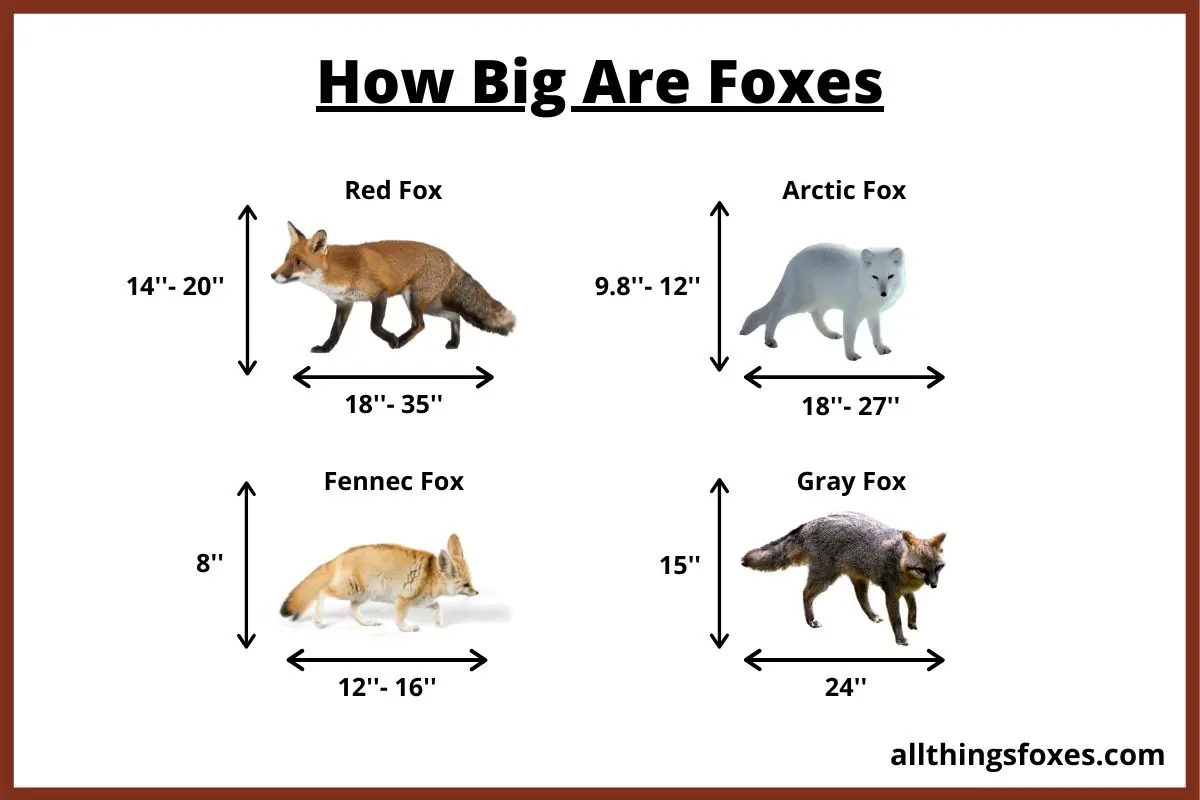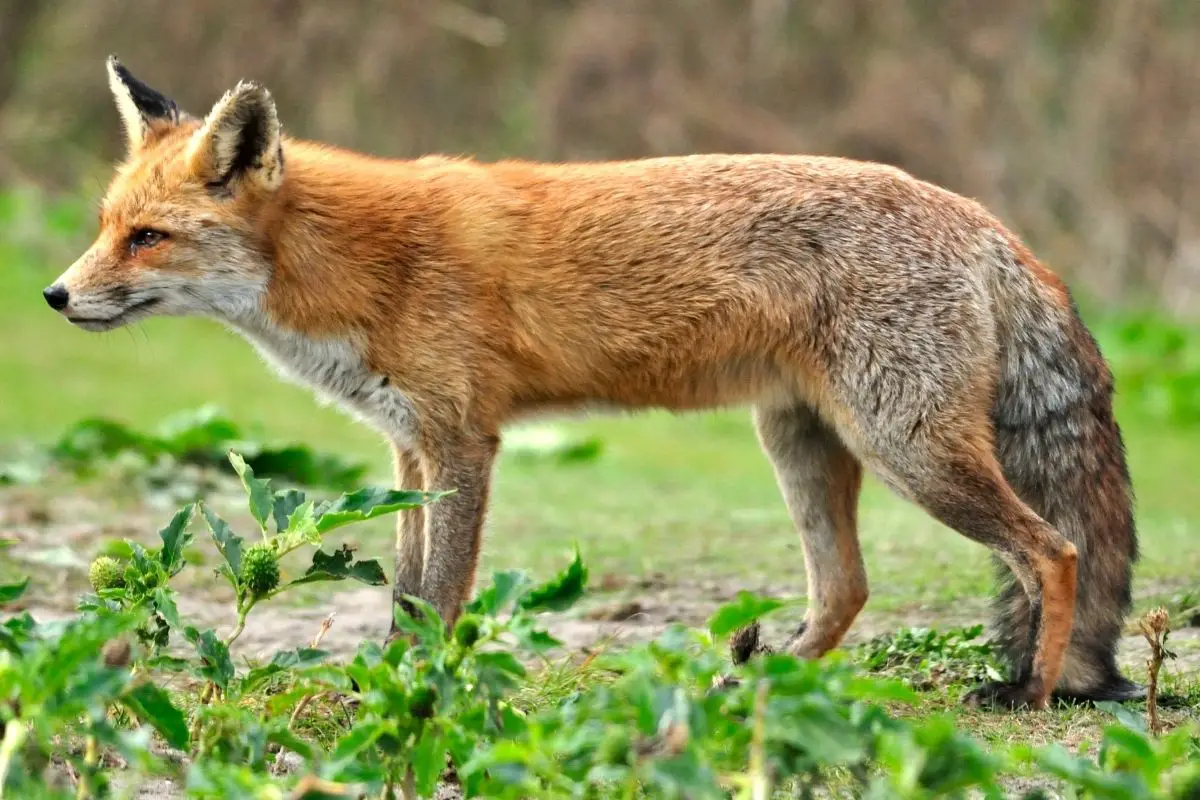There are over 30 fox species, and they come in various heights, lengths, and weights. Red foxes are the most common fox, and the most widely dispersed. They can be found on multiple continents and regions.
The average red fox is 14-20 inches tall (shoulder height) and 18-35 inches long. They weigh up to 31 pounds. Gray foxes and arctic foxes, are smaller, averaging around 24 inches long. Fennec foxes are the smallest fox, coming in at 8 inches tall and around 2-3 pounds.
Red foxes are the biggest of the fox species, with fennec foxes being one of the smallest canids in the world. Much of the fennec fox’s body is taken up by its large ears and tail, with their actual body size being very tiny.
How Big is the Biggest Fox
The biggest fox on record, unfortunately, was killed on a farm, after attacking farm animals. I do not like for any animal to be killed, other than for food, but protecting livestock is an important part of farming. My feelings aside, here are the facts. The largest fox killed in the UK was 38 pounds, and over 4 ft long.
It was killed on an Aberdeenshire farm, in Britain, after attacking lambs on the farm. The hunter was quoted as saying: “We take no real pleasure from it. It’s just what we have to do to stop them getting out of control.”
Foxes do not usually get this big, and it has been presented that foxes are being fed better in urban areas. Source.
Red Fox Size
As mentioned, red foxes are the largest of the fox species. Because they are larger, it makes them easier to tell them apart from gray foxes and arctic foxes. Because there are different color morphs of the red fox, it can be slightly tricky to tell them apart.
There are white color morph red foxes that look a lot like arctic foxes, the difference is in the shape of their faces, arctic foxes have wider faces and shorter snouts than red foxes.
| Red Fox | |
| Height | 14” to 20” Shoulder height. |
| Length | 18” to 35” long. |
| Weight | 15 to 31 pounds. |
Arctic Fox Size
Arctic foxes are smaller than red foxes. The males are typically bigger than the female arctic foxes. They can look much larger than they are during the winter months when they have a full winter coat.
| Arctic Fox | |
| Height | 9.8” to 12” Shoulder height. |
| Length | 18” to 27” long. |
| Weight | 10 pounds. |
Females arctic foxes tend to weigh closer to 6 pounds and are around 15 inches long.
Gray Fox Size
Gray foxes are also smaller than red foxes and are a little bigger than arctic foxes. You can tell a gray fox and a red fox apart by the black stripe on the back and tail of the gray fox. Red foxes have some unusual color morphs that look similar to gray foxes, so the size and the stripe sets them apart.
| Gray Fox | |
| Height | 15” Shoulder height. |
| Length | 24” long. |
| Weight | 8.5 pounds. |
Fennec Fox Size
Fennec foxes are very small. They are about the same size as chihuahua dog breeds. People used to think they were related, however, they come from completely different parts of the world and are different genus and species.
| Fennec Fox | |
| Height | 8” Shoulder height. |
| Length | 12” to “16 inches long. |
| Weight | 2 to 3 pounds. Source. |
Fennec foxes are from the desert regions of Africa and Arabia. They feed mostly on insects and rodents and absorb the water from the prey that they consume. In recent years, fennec foxes have been brought to American through the exotic pet trade. See our article for Fennec foxes as pets here.

Fox Kits Size
Fox kits (babies) are very small. They are about 4 inches long and weigh around 4 ounces. They are usually born with brown or charcoal gray fur and do not retain the color of their parents until later on. When they are this small, they cannot open their eyes.
They are blind for the first 12-14 days. After that, they start to grow quickly. They get to around 2.5 pounds in 4-6 weeks. You can tell the age of a fox kit by the color of its fur. After they start molting they are a neutral color for about 6 weeks, after that they start to show their colors.
Fox Skull Size
The skull of an average red fox is around 5.5 inches to 6.5 inches long and around 3 inches wide. The snout end of the skull is slender and long. Red foxes have 42 teeth. Their eye sockets are very large.
You can usually tell a fox skull from its canine teeth and the size of its eye sockets. It’s easy to tell them apart from dog skulls, which have a big dip/drop in the forehead, where foxes are long and straight.
How Big is a Fox Compared to a Coyote
Coyotes are much larger than foxes. Foxes have been compared with being the size of a very large house cat. Coyotes, on the other hand, get over 4 ft long and weigh up to 50 pounds. The easiest way to tell these two canids apart is by their size.
Because they are both members of the Canidae family, they tend to look a little bit similar. They both have large ears and large tails. However, they make different noises, are different sizes, it should be easy to tell one, from the other. See what we’ve written about foxes vs coyotes here.
How Big is a Fox Footprint
An average red fox footprint is around 1.5 inches wide and 2.5 inches in height. Foxes have 4 slender toes and a dewclaw. Red foxes have the biggest footprint, while arctic foxes, and gray foxes, have slightly smaller footprints.
Fennec foxes have much smaller footprints. Recognizing fox footprints can make it easier to identify if foxes are in your area. See more about fox footprints in our article here.
It doesn’t matter what size you are. It matters how big your heart is and how smart you are.
Freddy Adu
Conclusion
Foxes are not as big as some people might think. They are just big enough to take down prey like rabbits and lemmings. The fox feeds mostly on smaller animals, such as rodents. Many people think that foxes are pests but in reality, they kill pests like rodents.
Most wild dogs are much larger than foxes, which helps to tell if the wild canid in your area could be a dog or a fox. Foxes are solitary and tend to keep to themselves, while wild dogs tend to be loud and obvious.

